Chalcocite, Cu2S, Rhombic, Ab2m or Monoclinic, P21/c
< Specimen No. II-1 >
Specimen No. II-1, from the Osarizawa Mine, Akita Pref., occurs as oxidation product in an epithermal copper deposit. It is in a massive aggregate mixed with cube-shaped pyrite and chalcopyrite.
Djurleite, Cu15.75S8, Rhombic, Pmnm
< Specimens No.II-2—II-6 >
Specimens No. II-2-No. II-6, from the Osarizawa Mine, Akita Pref.,
occur as pseudomorph, so-called " harrisite ", after cube-shaped galena crystals
with a(100) and o(111) in drusy cavities in an epithermal quartz vein and
are associated with pyrite, chalcopyrite and barite (Fig. 5).

Bornite, Cu5FeS4, Tetragonal, P![]() 21c
21c
< Specimen No. II -7 >
Specimen No. II-7, from the Ikuno Mine, Hyogo Pref., occurs as a massive aggregate containing halcopyrite and pyrite in a xenothermal polymetallic deposit.
Argentite, Ag2S, Monoclinic, P21/n
< Specimens No. II-8—No. II-17 >
Specimens No. II-8—No. II-11, from the Innai Mine, Akita Pref., occur in black bands in quartz veins containing fine-grained electrum, pyrargyrite, stephanite and other sulphide minerals which were derived by epithermal mineralization. Argentite forms thin crustal aggregates and rounded cube-shaped grains in drusy cavities and fractures, and is associated with calcite.
Specimen No. II-12, from the Takatama Mine, Fukushima Pref., occurs as an aggregate of drop-shaped steel grey crystals in drusy cavities in an adularia-quartz vein of an. epithermal gold-silver deposit.
Specimen No, II-13, from the Sado Mine, Niigata Pref., occurs in a
black band, so-called "Ginguro" (Fig. 6), which consists of fine-grained electrum,
argentite, pyrargyrite and other sulphide minerals in an adularia-bearing
chalcedonic quartz vein of an epithermal gold-silver deposit.

Specimen No. II-14, from the Takachi Mine, Niigata Pref., occurs as small dropshaped grains in a drusy cavity in a quartz vein of an epithermal gold-silver deposit.
Specimens No. II-15—No. II-17, from the Nawaji Mine, Shizuoka Pref., occur in cavities and fractures in chalcedonic quartz in an epithermal gold-silver bearing quartz vein, and form thin incrustations and rounded small grains with a(100).
Sphalerite, α-ZnS, Cubic, F![]() 3m
3m
< Specimens No. II -18—No. II -79 > (Figs. 7-11)
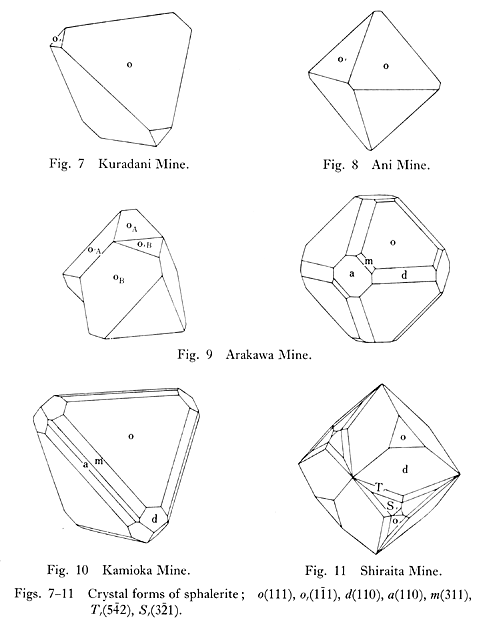
Specimens No. II -18—No. II -22, from the Daira Mine, Akita Pref.,
occur in drusy cavities in quartz veins from an epithermal copper-lead-zinc
deposit, and in association with chalcopyrite, pyrite, galena and calcite.
The crystals are black coloured octahedra with a(100), o(111) and o1(1![]() 1).
1).
Specimens No. II -23—No. II -30, from the Ani Mine, occur in
drusy cavities surrounded by crystalline quartz and chalcopyrite crystals
in an epithermal quartz vein, and form octahedral crystals with o(111), o1(1![]() 1),
a(100) and d(110). They are brown to deep brown in colour and transparent
to translucent. Twins after the spinel law are frequent (Plate 5).
1),
a(100) and d(110). They are brown to deep brown in colour and transparent
to translucent. Twins after the spinel law are frequent (Plate 5).

SPHALER1TE (No. II-30) Ani Mine, Akita Pref.
Specimens No. II-31—No. II-40, from the Osarizawa Mine, Akita Pref.,
occur, in association with chalcopyrite, pyrite, galena and calcite, in drusy
cavities in quartz veins in an epitherma copper-zinc-lead deposit, and form
octahedral crystals, up to 5 cm across and with o(111), o1(1![]() 1)
and d(110). They are yellowish brown to brown and tranparent to translucent,
and often show perfect parting parallel to o(111).
1)
and d(110). They are yellowish brown to brown and tranparent to translucent,
and often show perfect parting parallel to o(111).
Specimens No. II-41—No. II-47, from the Arakawa Mine, Akita Pref.,
occur, in association with chalcopyrite, galena, pyrite and calcite, in drusy
cavities of an epithermal quartz vein, and form tetrahedral crystals with
well-developed o(111) in combination with o1(1![]() 1),
dark brown to black in colour, and 2 cm in average diameter. Twins after the
spinel law are observed in specimen No. II-44.
1),
dark brown to black in colour, and 2 cm in average diameter. Twins after the
spinel law are observed in specimen No. II-44.
Specimen No. II-48, from the Miyazaki Mine, Miyagi Pref., occurs in
a drusy cavity of a quartz vein, and forms tetrahedral small crystals with
o(111), o1(1![]() 1) and
m(311), and brown to deep brown in colour.
1) and
m(311), and brown to deep brown in colour.
- Specimens No. II-49—No. II-52, are from the Hosokura Mine, Miyagi Pref. This mine is a zinc deposit of the epithermal type. There, sphalerite shows three modes of occurrence:
- (i) In drusy cavities of quartz veins in association with calcite, forming deep brown octahedral crystals. Twins after the spinel law appear as in specimen No. II-49,
- (ii) In quartz veins, and in alternating banding with grey fluorite, and,
- (iii) As deep brown massive or radial aggregates of acicular crystals a few centimeters long and with small amounts of galena and pyrite such as in specimen No. II-50. Though very rarely, wurtzite is observed in polished sections under the microscope.
Specimen No. II-53, from the Karatoya Mine, Yamagata Pref., occurs in a druse of an epithermal quartz vein cutting through an altered andesite, and forms pale brown and transparent crystals associated with quartz and chalcopyrite.
Specimen No. II-54, from the Iwanezawa Mine, Yamagata Pref., occurs as dark brown octahedral crystals in an epithermal quartz vein.
Specimens Nos. II-55 & II-56, from the Akabane Mine, Fukushima Pref., occur
in drusy cavities of an epithermal quartz vein bearing galena, pyrite and
chalcopyrite. They are black tetrahedral crystals with o(111) and o1
(1![]() 1).
1).
Specimen No. II-57, from the Donsuiwa Mine, Fukushima Pref., occurs in drusy cavities in an epithermal quartz vein bearing chalcopyrite and crystalline quartz, and forms tetrahedral crystals 4 cm across. Twins after the spinel law appear.
Specimens No. II-58—No. II-63, from the Ashio Mine, Tochigi Pref.,
occur in drusy cavities of chalcopyrite ores in a hydrothermal replacement
deposit, so-called "Kajika deposit". They form black crystals with o(111),
o1(1![]() 1)and a(100),
and sometimes develop into hexagonal short prismatic crystals according to
repetition of spinel twinning on o(111). Associated minerals are chalcopyrite,
pyrite and quartz. Hexagonal tabular crystals of apatite are also found with
sphalerite in specimen No. II-59 (Fig. 12).
1)and a(100),
and sometimes develop into hexagonal short prismatic crystals according to
repetition of spinel twinning on o(111). Associated minerals are chalcopyrite,
pyrite and quartz. Hexagonal tabular crystals of apatite are also found with
sphalerite in specimen No. II-59 (Fig. 12).

Specimens No. II-64—No. II-66, from the Taihei Mine, Shizuoka Pref.,
occur in drusy cavities of an epithermal quartz vein bearing chalcopyrite
and pyrite, and cutting through a rhyolitic rock. They form brown tetrahedral
crystals with o(111) and o1(1![]() 1).
Twins after the spinel law are common.
1).
Twins after the spinel law are common.
Specimens Nos, II-67 & II-68, from the Shiraita Mine, Niigata Pref.,
occur as megacrystals in drusy cavities of an epithermal quartz vein bearing
galena andchalcopyrite. The crystals are yellowish brown to brown and transparent.
The dominant faces observed are d(110), o(111), S1(3![]() 1)
and T1(5
1)
and T1(5![]() 2). The largest
crystal measures 15 cm in diameter.
2). The largest
crystal measures 15 cm in diameter.
Specimens Nos. II-69 & II-70, from the Kamioka Mine, Gifu Pref., occur
in aggregates of hedenbergite, andradite and calcite in a contact metasomatosed
zinclead deposit. The crystals of sphalerite grown in drusy cavities are black
and tetrahedral with o(111), o1(1![]() 1)
and m(311), with edges measuring about 1 cm, and are associated with calcite
and quartz. Specimen No. II-69 shows a banding with deep brown parts.
1)
and m(311), with edges measuring about 1 cm, and are associated with calcite
and quartz. Specimen No. II-69 shows a banding with deep brown parts.
Specimens No. II-71- No. II-74, from the Kuradani Mine, Ishikawa Pref.,
occur in drusy cavities of a sphalerite-chalcopyrite-pyrite quartz vein and
are associated with chalcopyrite, pyrite, jamesonite and barite. They form
aggregates of black tetrahedral crystals with o(111) and o1(1![]() 1).
Twins after the spinel law appear.
1).
Twins after the spinel law appear.
Specimen No. II-75, from the Omodani Mine, Fukui Pref., occurs in drusy
cavities of a quartz vein of an epithermal copper-lead-zinc deposit, forming
black tetrahedral crystals with o1(1![]() 1)
and attaining 5 cm along the edge.
1)
and attaining 5 cm along the edge.
Specimens Nos. II-76 & II-77, from the Bandojima Mine, Fukui Pref., occur in drusy cavities of an epithermal quartz vein. Pyrite is associated. The individual crystals are rarely sufficiently distinct to allow an accurate determination, the only face recognizable being o(111) on which triangular striations are observed.
Specimen No, II-78, from the Obira Mine, Oita Pref., occurs in a druse
in quartz in a pneumatolytic metasomatosed deposit and in association with
crystalline quartz, prismatic crystals of arsenopyrite and greenish grey acicular
crystals of tourmaline. It forms a deep grey megacrystal with o(111) and o1(1![]() 1)
(Fig. 13).
1)
(Fig. 13).

Specimen No. II-79, locality unknown, occurs on crystalline quartz associated with chalcopyrite and galena, and forms tetrahedral crystals brown in colour.
Chalcopyrite, CuFeS2, Tetragonal, I![]() 2d
2d
< Specimens No. II-80—No. II-281 >
Specimens No. II-80—No. II-82, from the Osarizawa Mine, Akita Pref., occur in drusy cavities of a quartz vein bearing barite and cube-shaped pyrite, and form tetrahedral crystals covered by thin crusts of malachite.
Specimens No. II-83—No. II-98, from the Ani Mine, Akita Pref.,
occur in drusy cavities of quartz veins in an epithermal copper-lead-zinc
deposit and in association with galena, pyrite, chlorite and calcite. The
crystals take the form of tetrahedron or deltoid dodecahedron. In crystals
in the former form, p(112) is dominant and in those in the latter, principal
faces are y(316) and X(332). Sometimes, they present twins with "ears" which
are due to penetration twinning on (112) (Fig. 17).
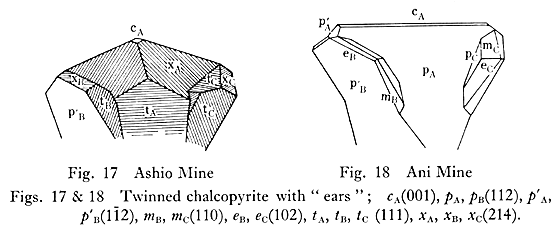
Specimen No. II-99, from the Furokura Mine, Akita Pref., consists of crystals of tetrahedral forms about 1 cm across, and occurs in association with crystalline quartz and pyrite in a quartz vein.
Specimens No. II-100—No. II-246, are from the Arakawa Mine, Akita
Pref. This mine, now closed, is the most interesting locality of chalcopyrite
crystals which occur in drusy cavities in epithermal quartz veins, and are
associated with sphalerite, galena, pyrite, hematite, chlorite and calcite.
The chalcopyrite crystals from this locality show four principal types of
form as follows: (1) Tetrahedral with p(112) such as in specimen No. II-107,
(2) Deltoid-dodecahedral with the combination of x(116) and t(111), or of
y(316) and X(332), such as in specimen No. II-121, (3) Rhombic-dodecahedral
with e(102) and m(110), and (4) Triangular with the combination of m(110),
p(112), p1(1![]() 2) and e(102), showing
varieties from triangular platy to acicular or needle-like in [110] such as
in specimens No. II-135—No.II-137. Sometimes, these crystals form penetration
twins with "ears" such as in specimens Nos. II-133 & II-134. In specimen No.
II-140, crystals are replaced by limonite, resulting in pseudomorphs (Plate
6, Figs. 14-16).
2) and e(102), showing
varieties from triangular platy to acicular or needle-like in [110] such as
in specimens No. II-135—No.II-137. Sometimes, these crystals form penetration
twins with "ears" such as in specimens Nos. II-133 & II-134. In specimen No.
II-140, crystals are replaced by limonite, resulting in pseudomorphs (Plate
6, Figs. 14-16).

CHALCOPYRITE (No. II-200) Arakawa Mine, Akita Pref.

CHALCOPYRITE (No. II-201) Arakawa Mine, Akita Pref.


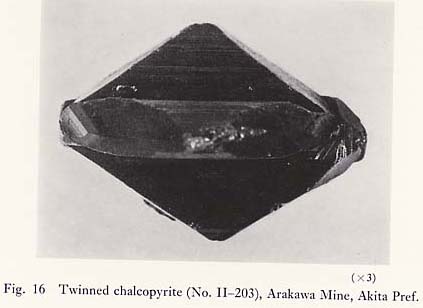
Specimen No. II-247, from the Sachu Mine, Akita Pref., occurs on crystalline quartz in drusy cavities of a quartz vein as tetrahedral crystals with p(112).
Specimens No. II-248—No. II-250, from the Daichi Mine, Akita Pref., occur in drusy cavities of a quartz vein bearing pyrite and sericite, and form tetrahedral crystals with p(112) and penetration twins.
Specimen No. II-251, from the Mizusawa Mine, Iwate Pref., occurs as tetra- hedral crystals on crystalline quartz in cavities of a quartz vein and is associated with pyrite and chlorite in an epithermal copper deposit.
Specimens No. II-252—No. II-269, from the Ashio Mine, Tochigi
Pref., occur in drusy cavities of massive copper ores in a hydrothermal replacement
deposit, so-called "Kajika deposit". The crystals abound in forms and sometimes
show rough and dull faces. Their principal faces are the combination of x(116)
and t(111), or y(316) and X(332) to form a deltoid dodecahedron, p(112) and
n(114) to form a tetrahedron such as in specimens No. II-261 and No. II-262,
c(001), p(112) and p1(1![]() 2)
to form a tabular crystal such as in specimens No. II-258—No. II-260.
The largest crystal measures 4 cm in diameter (Figs. 18-20). Penetration twins
are frequent.
2)
to form a tabular crystal such as in specimens No. II-258—No. II-260.
The largest crystal measures 4 cm in diameter (Figs. 18-20). Penetration twins
are frequent.

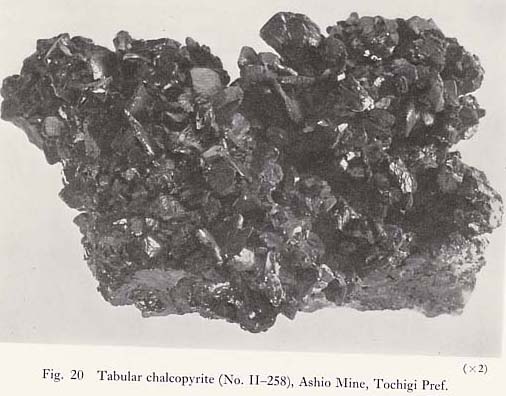
Specimen No. II-270, from the Otome (Kurasawa) Mine, Yamanashi
Pref., occurs, as an isolated megacrystal 18 cm in diameter, from a pneumatolytic
quartz vein. Its surface is tarnished into dark grey. Pyrite is associated
with it in the form of inclusion (Fig. 21).
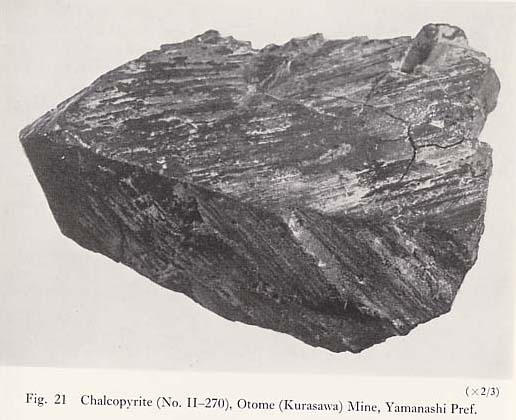
Specimen No. II-271, from the Fukumitsu Mine, Toyama Pref., occurs on cry- stalline quartz in a druse of an epithermal copper deposit, and. forms tetrahedral crystals with p(112).
Specimens No. II-272—No. II-274, from the Yusenji Mine, Ishikawa Pref., are tetrahedral crystals grown over crystalline quartz in a chalcopyrite-pyrite-bearing chlorite quartz vein. Sometimes, penetration twins appear such as in speciman No. II-274.
Specimens Nos. II-275 & II-276, from the Ogoya Mine, Ishikawa Pref., occur in drusy cavities of a quartz vein of an epithermal copper deposit, forming tetra- hedral crystals withp(112) and tarnished dark grey in colour. Associated mineralsare crystalline quartz and pentagonal dodecahedral crystals of pyrite.
Specimen No. II-277, from the Kuratani Deposit of the Ogoya Mine, Ishikawa Pref., occurs on crystalline quartz in drusy cavities of an epithermal chalcopyritepyrite-quartz vein, and forms tetrahedral crystals with p(112) and triangular crystals with e(102), p(112) and m(110) as principal faces. The largest crystal in the tetrahedral form is 2 cm in diameter.
Specimens Nos. II-278 & II-279, from the Kanagase Deposit of the Ikuno Mine, Hyogo Pref., occur as tetrahedral crystals, up to about 5 mm across, on crystalline quartz in cavities of a quartz vein in a xenothermal polymetallic deposit.
Specimens Nos. II-280 & II-281, from the Akenobe Mine, Hyogo Pref., occur in drusy cavities of a quartz vein and are associated with calcite. They are crystals with x(116), t(111) and p(112).
Tennantite, Cu10(Fe, Zn)2(As, Sb)4
S13 Cubic, I![]() 3m
3m
< Specimens Nos. II-282 & II-283 >
Specimens Nos. II-282 & II-283, from the Kanagase Deposit of the Ikuno Mine, Hyogo Pref., occur in drusy cavities of a quartz vein in a xenothermal polymetallic deposit, and form small tetrahedral crystals with well-developed o(111) and a(100).
Tetrahedrite, Cu10(Fe, Zn)2(Sb, As)4S13,
Cubic, I![]() 3m
3m
< Specimens No. II-284—No. II-286 > (Figs. 22-24)
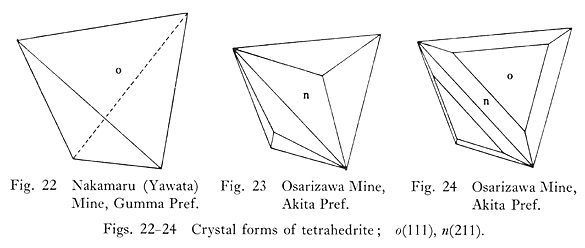
Specimen No. II-284, from the Teine Mine, Hokkaido, consists of small tetrahedral crystals, up to 1 mm across, and with o(111), in drusy cavities and fractures in a barite-quartz vein.
Specimen No. II-285, from the Osarizawa Mine, Akita Pref., occurs in drusy cavities and fractures in a quartz vein of an epithermal copper deposit, and forms massive aggregates, or separated tetrahedral crystals reaching 3 mm across and with o(111) and a(100).
Specimen No. II-286, from the Nakamaru (Yawata) Mine, Gumma Pref., occurs as crystals in a tetrahedral form with o(111) on crystalline quartz in drusy cavities of an epithermal quartz vein. It is associated with sphalerite and pyrite.
Greenockite, β-CdS, Hexagonal, P63mc
< Specimens No. II-287-No. II-289 >
Specimens No. II-287—No. II-289, from the Kamioka Mine, Gifu Pref., are a secondary product, occur as powdery incrustations showing bright orange-yellow colour in fractures of massive hedenbergite in a contact metasomatosed lead-zinc deposit, and are associated with sphalerite, galena, hemimorphite and actinolite.
Enargite, Cu3AsS4, Rhombic, Pnm21
< Specimens No. II-290—No. II-297 >
Specimen No. II-290, from the Okoppe Mine, Aomori Pref., consists
of black prismatic crystals up to 3 mm long, and occurs in drusy parts in
a massive sulphide ore composed of pyrite in a Kuroko deposit (Fig. 25).
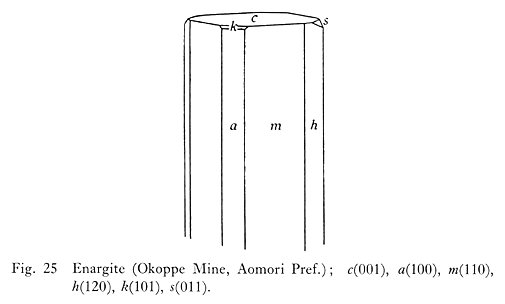
Specimens No. II-291—No. II-297, from the Kinkaseki Mine, Formosa,
are black short prismatic crystals reaching about 3 cm in length and occur
in drusy cavities in massive enargite associated with fine-grained aggregates
of luzonite in an epithermal copper-gold deposit. Principal faces observed
are a(100), m(110), c(001) and k(101) (Fig. 26).

Pyrrhotite, FeS, Hexagonal, P63/mmc
< Specimens No. II-298—No. 11-303 >
Specimens No. II-298-No. II-300, from the Ashio Mine, Tochigi Pref.,
occur in drusy cavities of a chalcopyrite ore in a xenothermal polymetallic
deposit, forming hexagonal plates and short prismatic crystals on chalcopyrite
crystals. The largest platy crystal measures 3 cm in diameter. Associated
minerals are chalcopyrite,sphalerite, siderite and apatite (Fig. 27).
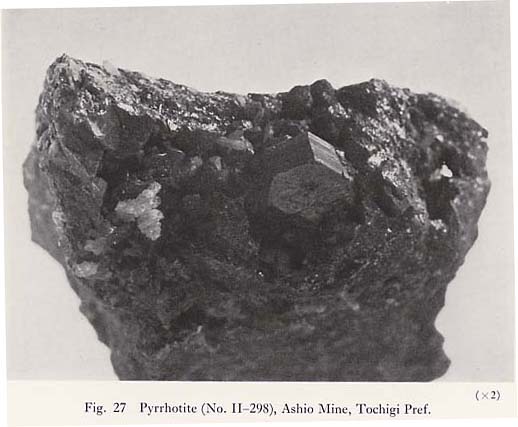
Specimen No. II-301, from Tenryu Mine (Aokuzure), Nagano Pref., occurs in serpentinized peridotite as orthomagmatic nickel deposit, and forms a massive aggregate of crystals with basal parting. An associated mineral observed under the microscope is pentlandite which shows a lamellar texture with pyrrhotite.
Specimens Nos. II-302 & II-303, from the Yoshioka Mine, Okayama Pref.,occur
as hexagonal plates in druses of a calcite-quartz vein cutting through chlorite
schist and a granitic rock. The largest crystal is 1 cm in diameter (Fig.
28).

Niccolite, NiAs, Hexagonal, P63/mmc < Specimens Nos. II-304 & II-305 >
Specimens Nos. II-304 & II-305, from the Natsume Mine, Hyogo Pref., occur as nodular masses in fractures of serpentinite. Their interior shows a concentric banding of copper-coloured niccolite with light grey gersdorffite, both associated with a small amount of pyrrhotite.
Alabandite, α-MnS, Cubic, Fm3m
< Specimens Nos. II-306 & II-307 >
Specimens Nos. II-306 & II-307, from the Taisei Mine, Akita Pref.,
occur in an epithermal rhodochrosite vein, and form massive aggregates of
a banded texture. They are brownish black in colour (Plate 6).
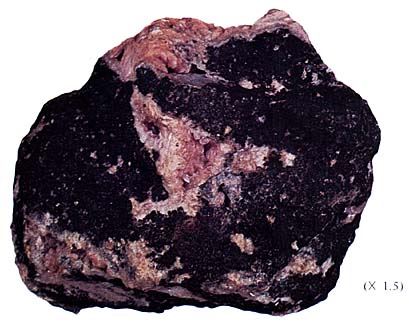
ALABANDITE (No. II-303) Taisei Mine, Akita Pref.
Galena, PbS, Cubic, Fm3m
< Specimens No. II-308—No. II-337> (Figs. 29-32)
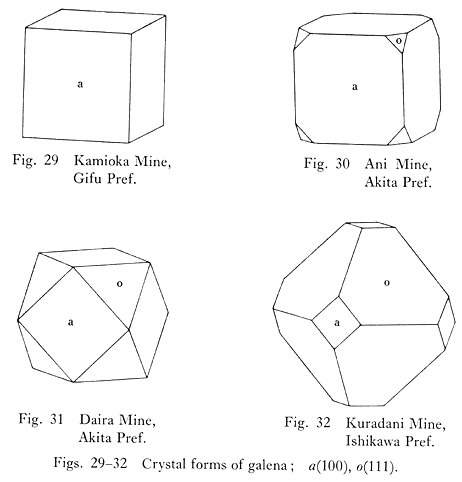
Specimens No. II-308—No. II-315, from the Daira Mine, Akita Pref.,
occur as crystals with a(100) and o(111) on black sphalerite associated with
thin pyrite in an epithermal quartz vein. Frequently the crystals are coverde
with aggregates of fine crystalline quartz and small calcite crystals. The
largest crystal shows an edge 5 cm long (Plate 5).
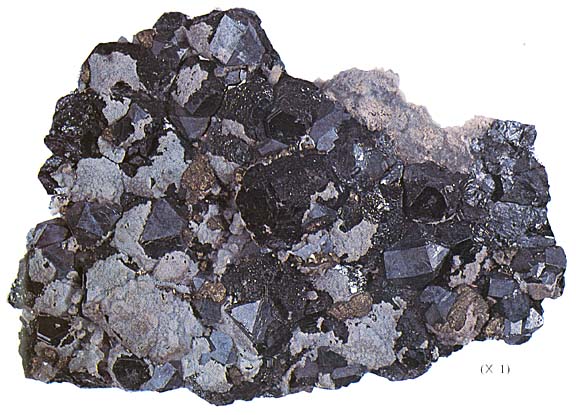
GALENA (No. II-305) Daira Mine, Akita Pref.
Specimens No. II-316—No. II-319, from the Osarizawa Mine, Akita Pref., occur as cubic crystals with o(111) in druses of a quartz vein in an epithermal copperlead-zinc deposit, and. are associated with pyrite, chalcopyrite and calcite. The largest crystal measures 3 cm in diameter.
Specimens No. II-320—No. II-323, from the Ani Mine, Akita Pref., occur on crystalline quartz and chalcopyrite in drusy cavities in an epithermal quartz vein bearing pyrite and sphalerite. The crystals are in a cubic form with a(100) and o(111).
Specimen No. II-324, from the Arakawa Mine, Akita Pref., occurs in drusy cavities in an epithermal quartz vein, is associated with sphalerite and chlorite, and forms cube-shaped crystals with a(100) whose edges reach 5 mm in length.
Specimen No. II-325, from the Hatsuishi Deposit, Arakawa Mine, Akita
Pref., occurs as small cube-shaped crystals with rounded edges in drusy cavities
in an epithermal quartz vein bearing sphalerite and pyrite (Fig. 33).
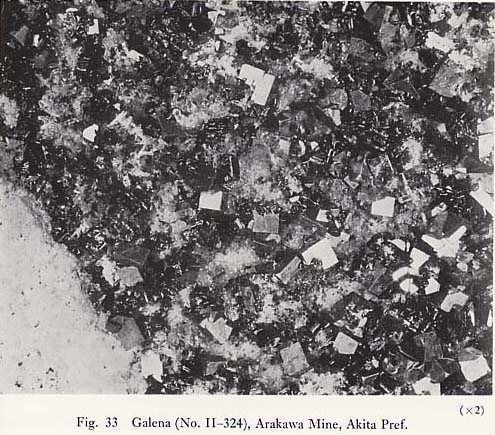
Specimens Nos. II-326 & II-327, from the Okubo Mine, Fukushima Pref., occur in drusy cavities in an epithermal quartz vein, are associated with chalcopyrite, and form cube-shaped crystals, reaching 15 mm in diameter and sometimes showing a skeleton figure on a(100).
Specimen No. II-328, from the Shiraita Mine, Niigata Pref., occurs in drusy cavities in an epithermal quartz vein, is associated with sphalerite and chalcopyrite, and forms cube-shaped crystals.
Specimen No. II-329, from the Mozumi Deposit of the Kamioka Mine, Gifu Pref., occurs in a contact metasomatosed zinc-lead deposit, forms cubic crystals on black sphalerite, and shows a skeleton figure on a(100).
Specimens Nos. II-330 & II-331, from the Kamioka Mine, Gifu Pref., occur as cubic crystals with a(100) and o(111) in cavities in a zinc-lead contact metasomatosed deposit, and are associated with sphalerite, calcite and quartz, the latter two minerals grown over the galena crystals. Skeletal figures are observed on the faces with molten edges. The largest crystal shows an edge reaching 5 cm in length.
Specimen No. II-332, from the Kuradani Mine, Ishikawa Pref., occurs in a druse of an epithermal quartz vein bearing chalcopyrite and pyrite, and forms crystals up to 1 cm across and with the combination of o(111) and a(100).
Specimens No. II-333—No. II-335, from the Bandojima Mine, Fukui Pref., occur in drusy cavities of vein-quartz in an epithermal zinc-lead deposit, and form crystals with the combination of a(100) and o(111). Their surfaces are often etched or corroded, and sometimes show a molten appearance. They are generally a few centimeters along the edge. Associated minerals are pyrite and sphalerite.
Specimens Nos. II-336 & II-337, from the Omodani Mine, Fukui Pref., occur in an epithermal chalcopyrite-sphalerite-bearing quartz vein. They form aggregates of cube-shaped crystals showing skeletal figures on a(100), and are tarnished into bluish colour.
Altaite, PbTe, Cubic, Fm3m
< Specimen No. II-338 >
Specimen No. II-338, from the Nojiri Mine, Iwate Pref., occurs in fractures and intergranular spaces in milky-white quartz in a mesothermal gold-silver deposit. It is in small grains tarnished into black and commonly associated with pyrite. Under the ore-microscope, petzite, hessite and sylvanite are observed in this specimen.
Miargyrite, AgSbS2, Monoclinic, C2/c
< Specimens No. II-339—No. II-341 >
Specimens No. II-339—No. II-341, from the Bajo Mine, Oita Pref., occur in drusy parts or fractures of a quartz vein in an epithermal gold-silver deposit, and form massive aggregates of granular crystals associated with pyrargyrite. Their faces are however not sufficiently well-developped for an accurate determination.
Cinnabar, HgS, Trigonal, P3121 and P3221
< Specimens No. II-342—No. II-356 >
Specimen No. II-342, from Shizunaimachi, Hokkaido, occurs as an aggregate of fine-grained crystals in a quartz vein cutting through a metamorphic rock.
Specimens Nos. II-343 & II-344, from the Shamani Mine, Hokkaido, occur as aggregates of small crystals in association with minute drops of native mercury in white quartz in an epithermal mercury deposit.
Specimens No. II-345—No. II-347, from Onnenai, Hokkaido, occur as impregnations in a quartz vein, forming massive aggregates.
Specimen No. II-348, from the Uryugawa, Hokkaido, occurs as pebbles or in sand in an auriferous placer deposit.
Specimens Nos. II-349 & II-350, from Tonbetsu, Hokkaido, occur in sand in an auriferous placer deposit.
Specimen No. II-351, from Komagaeri, Nara Pref., occurs in an epithermal quartz vein, forming a massive aggregate.
Specimens Nos. II-352 & II-353, from the Yamato Mine, Nara Pref.,
occur as epithermal networks or disseminated veinlets in a gneissose granite.
Associated minerals are quartz, calcite and marcasite (Plate 7).
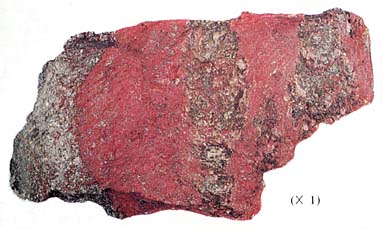
CINNABAR (No. II- 352) Yamato Mine, Nara Pref.
Specimen No. II-354, from Tomack-dong, Korea, occurs as veinlets in a gold- bearing quartz vein cutting through gneiss. It is associated with ankerite.
Specimen No. II-355, from Toriisawa, U.S.S.R., occurs in sand on a stream beds.
Specimen No, II-356, from Otomari, U.S.S.R., occurs as pebbles in a stream beds.
Covelline, CuS, Hexagonal, P63/mmc
< Specimens No. II-357—No. II-362 >
Specimens No. H-357—No. II-362, from the Motoyama Deposit of the Kosaka
Mine, Akita Pref., occur as aggregates of thin platy hexagonal crystals
in cavities and fractures of a chalcopyrite-bearing massive pyrite ore which
has been subjected to secondary enrichment by oxidation in a Kuroko deposit
(Fig. 34).

Stibnite, Sb2S3, Rhombic, Pbnm
< Specimens No. II-363—No. II-396 >
Specimens Nos. II-363 & II-364, from the Tsugu Mine, Aichi Pref., occur in druses in an epithermal quartz vein bearing pyrite and sphalerite, and form loose mats of acicular crystals about 1 cm long.
Specimen No. II-365, from the Nakase Mine, Hyogo Pref., occurs as product of epithermal minerallization in druses of a quartz vein. It forms a group of steel grey and long needle-like crystals. They are a few millimeters in width and 5 cm in length.
- Specimens No. II-366- No. II-393, from the Ichinokawa Mine, Ehime Pref., This mine comprises quartz-stibnite veins cutting through graphite schist of the Sambagawa metamorphic series. Stibnite occurs in groups on the surfaces of druses lined with quartz crystals. The crystals are in well-defined and long prismatic forms with a(100), b(010), h(310), h(210), m(110), p(331), τ(341), η(351) and T(241), and classified into two types:
- (1) With p(331), τ(341) and η(351) as principal terminal faces,
- (2) With T(241) as principal terminal faces, though some crystals exhibit a habit of intermediate character. The largest single crystal reaches 30 cm in length. Most of them are tarnished on their surfaces (Plate7, Figs. 35 & 36).
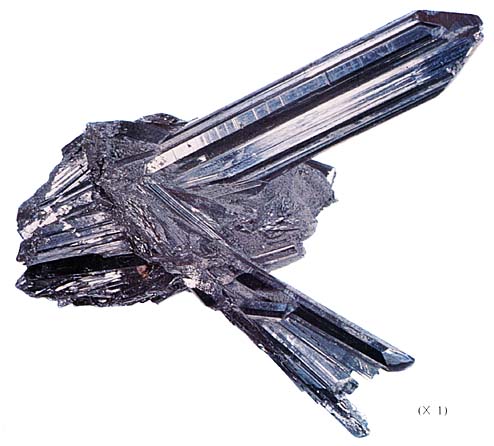
STIBNITE (No. II-377) Ichinokawa Mine, Ehime Pref.
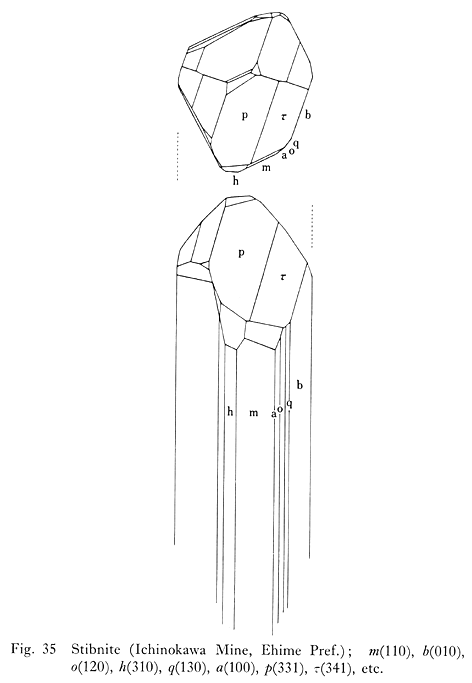

Specimens Nos. II-394 & II-395, from the Bajo Mine, Oita Pref., occur in the fracture zone of an epithermal gold-silver-quartz vein, forming aggregates of acicular crystals in association with quartz and sericite. The crystals are 1 cm long on an average.
Specimen No. II-396, from the Ushio Deposit of the Oguchi Mine, Kagoshima Pref., occurs on crystalline quartz in druses of an epithermal gold-silver-bearing quartz vein, and forms fine acicular crystals.
Bismuthinite, Bi2S3, Rhombic, Pbnm
< Specimens No. II-397—No. II-402 >
Specimen No. II-397, from the Nakanosawa Mine, Niigata Pref., occurs in irregular forms within a thin rim of alteration product in native bismuth in an epithermal quartz vein. Earthy crusts of bismite are observed in cracks and on sur faces of the mass of quartz grains containing native bismuth and bismuthinite.
Specimens No. II-398-No. II-400, from the Tsubakihafa Mine, Gifu Pref., occur in a pneumatolytic quartz vein as small massive aggregates of fine-grained crystals and as alteration product surrounding native bismuth. Though rarely, lillianite (Pb3Bi2S6) and heyrovskyite (Pb6Bi2S9) were sometimes found in such a mineral assemblage as above, but have not been identified in these specific specimens.
Specimens Nos. II-401 & II-402, from the Yokozuru Deposit, Sannotake, Fukuoka Pref., occur as a thin rim of alteration product in massive native bismuth, 2 to 3 mm in diameter and filling interstices of granular grossular in a contact metaso matosed deposit. Calcite and scheelite are associated.
Tellurobismutite, Bi2Te3, Trigonal, R![]() m
m
< Specimens Nos. II-403 & II-404 >
Specimens Nos. II-403 & II-404, from the Oya Mine, Miyagi Pref., occur in milky-white quartz in a mesothermal gold-silver deposit, and form aggregates of minute thin hexagonal plates in association with native gold.
Ikunolite, Bi4(S, Se)3, Trigonal, R![]() m
m
< Specimen No. II-405 >
Specimen No. II-405, from the Kanagase Deposit of the Ikuno Mine, Hyogo Pref., occurs in massive quartz in a xenothermal polymetallic deposit. It is inti mately associated with native bismuth and usually covered by bismuthinite. Other co-existing minerals are ferberite and sporadic cassiterite. Ikunolite forms small platy crystals without faces other than (0001), which is the plane of perfect cleavage. The crystals are about 1 mm in diameter and lead-grey in colour.
Pyrite, FeS2, Cubic, Pa3
< Specimens No. II-406—No.II-461 >
Specimens Nos. II-406 & II-407, from the Daichi Mine, Akita Pref., occur as cubic crystals on crystalline quartz in drusy cavities in a quartz vein of an epithermal copper deposit. They are 2 cm in diameter.
Specimens No. II-408—No. II-410, from the Saruma Mine, Akita Pref., occur in drusy cavities in an epithermal quartz vein, and form pentagonal dodecahedral or cubic crystals, often tarnished into brown. Faces observed on the pentagonal dodecahedral crystals are e(210), o(111) and t(421). The cubic crystals are 25 mm in diameter on an average.
Specimen No. II-411, from the Motoyama Deposit of the Kosaka Mine, Akita Pref., is from drusy parts of a massive sulphide ore in a Kuroko deposit. The crystals are either in cubes or in pentagonal dodecahedra up to 65 mm in diameter.
Specimens No. II-412—No. II-415, from the Ani Mine, Akita Pref., occur in drusy cavities in a pyrite-chalcopyrite-quartz vein in aggregates or as single crystals in cubes or pyritohedra with e(210) and a(100) and with edges 3 to 4 cm long.
Specimen No. II-416, from the Hakusan Mine, Akita Pref., occurs in drusy cavities in a sphalerite-bearing quartz vein, forming a botryoidal aggregate associated with calcite.
Specimens No. II-417—No. II-430, from the Arakawa Mine, Akita
Pref., form aggregates of cubic or pyritohedral crystals occurring on crystalline
quartz in drusy cavities in a hematite-chlorite-quartz vein and are associated
with chalcopyrite. The largest crystal in specimen No. II-425 is 6 cm in diameter
(Fig. 37).

Specimen No. II-431, from the Matsukawa Mine, Akita Pref., occurs as octa hedral crystals, about 1 cm across, grown on crystalline quartz in drusy cavities in an epithermal quartz vein.
Specimens No. II-432—No. II-436, from the Washiaimori Mine, Akita Pref., occur in a chalcopyrite-bearing chlorite-quartz vein of an epitermal copper deposit. The crystals show a cubic form consisting of a(100) and o(111), and a pentagonal dodecahedral form consisting of e(210) and a(100). Pyrite in specimen No. II-436 forms botryoidal aggregates in drusy cavities in the vein. These specimens are as sociated with chalcopyrite, sphalerite, galena, chlorite and calcite.
Specimen No. II-437, from the Sennin Mine, Iwate Pref., occurs in
a contact metasomatosed iron deposit, is associated with andradite, actinolite,
hematite and quartz, and forms isolated octahedral or pyritohedral crystals
up to about 2 cm in diameter (Fig. 38).
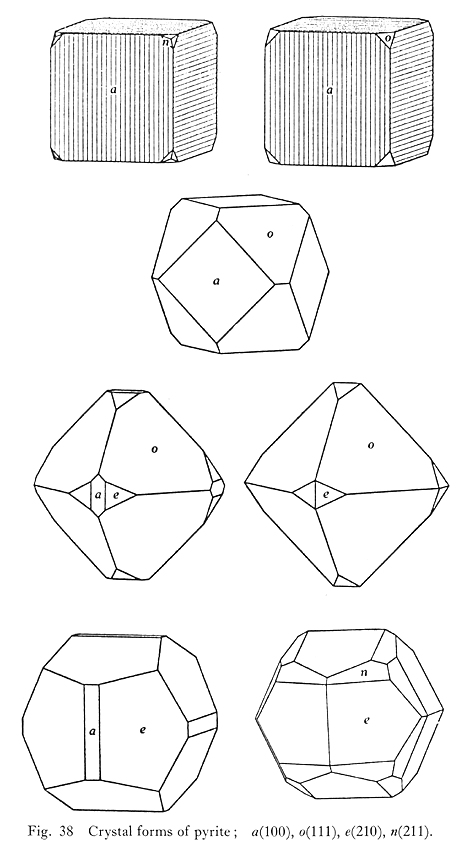
Specimens No. II-438—No. II-443, from the Tsunatori Mine, Iwate Pref., occur in cavities of a massive sulphide ore bearing chalcopyrite and quartz from a Kuroko deposit. Pyrite in these specimens forms well-defined crystals a few centi meters across and either in cubes or in pyritohedra consisting of a(100), o(111) and e(210).
Specimens Nos. II-444 & II-445, from the Hitachi Mine, Ibaraki Pref., occur as porphyroblasts in a massive sulphide ore composed of pyrite and chalcopyrite and form cubic crystals. The largest crystal measures 6 cm in diameter.
Specimen No. II-446, from the Akatani Mine, Niigata Pref., occurs
in a contact metasomatosed hematite deposit. The crystals show a peculiar
habit owing to development of alternate six faces of a pentagonal dodecahedron,
and are up to 2 cm across in size (Fig. 39).

Specimen No. II-447, from the Yahiko Mine, Niigata Pref., is isolated pyrito hedral crystals up to 1 cm across, occurring in an epithermal chalcopyrite-bearing quartz vein.
Specimen No. II-448, from Koganesawa, Nagano Pref., is isolated cubic crystals attaining 1 cm in diameter.
Specimen No. II-449, from Takeshi, Nagano Pref., occurs in an altered andesitic tuff as a deep brown-coloured limonite pseudomorph, in a form of pyritohedron consisting of e(210) and a(100), and. up to 15 mm in diameter.
Specimen No. II-450, from the Yusenji Mine, Ishikawa Pref., occurs in an epithermal chalcopyrite-chlorite-quartz vein, forming pyritohedra.
Specimens Nos. II-451 & II-452, from the Ogoya Mine, Ishikawa Pref., occur in an epithermal chalcopyrite-pyrite-quartz vein as pentagonal dodecahedral crystals with e(210) and a(100) and also as cubic crystals.
Specimen No. II-453, from the Akenobe Mine, Hyogo Pref., occurs as aggre gates of minute crystals on crystalline quartz in drusy cavities in a xenothermal quartz vein.
Specimen No. II-454, from the Kawakami Mine, Hyogo Pref., forms cube shaped crystals attaining 2 cm. along the edge.
Specimen No. II-455, from the Iwami Mine, Tottori Pref., is isolated crystals in pentagonal dodecahedra with a small face of o(111), and occurs in an epithermal copper deposit. The size of the crystal is about 5 cm in diameter.
Specimens No. II-456—No. II-458, from the Udo Mine, Shimane Pref., occur as pyritohedra or octahedra in drusy parts of a massive sulphide ore from a Kuroko deposit. Faces observed are dominant e(210) and small o(111) in pyritohedra, and dominant o(111) and small e(210) in octahedra.
Specimen No. II-459, from the Sagi Mine, Shimane Pref., is isolated octahedral crystals from a massive sulphide ore in a Kuroko deposit.
Specimen No. II-460, from the Obira Mine, Oita Pref., occurs as product of pneumatolytic metasomatism in cavities in quartz, and forms cube-shaped crystals with dominant a(100) and small o(111) and attaining 25 mm across.
Specimen No. II-461, from the Anzan Mine, China, is an isolated cube-shaped pseudomorph replaced by limonite, and is from a contact iron deposit. It is about 5 cm along the edge.
Cobaltite, CoAsS, Cubic, Pa3
< Specimens No. II-462—No. II-464 >
Specimens No. II-462—No. II-464, from the Yoboshi Deposit of the Naganobori
Mine, Yamaguchi Pref., occur in a massive skarn composed of hedenbergite,
lievrite, quartz and calcite, and form silver-white aggregates of granular
crystals up to 3 mm in diameter (Fig. 40). The only face observed is a(100).
Associated minerals are chalcopyrite, pyrite and a small amount of scheelite.
These specimens are locally covered by thin incrustations of erythrite, showing
vivid purple colour.
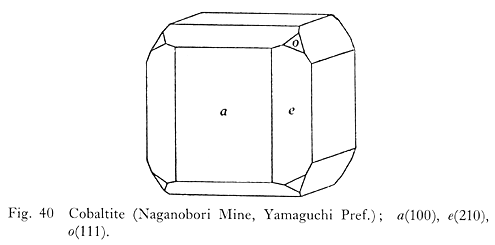
Gersdorffite, NiAsS, Cubic, Pa3
< Specimen No. II-465 >
Specimen No. II-465, from the Natsume Mine, Hyogo Pref., occurs as a rounded mass in serpentinite. The interior of the mass shows a concentric texture with alternate banding of gersdorffite and niccolite in both of which minute crystals of pyrrhotite are included. Gersdorffite is silver-grey, and niccolite is pale copperred.
Marcasite, FeS2 Rhombic, Pmnm
< Specimens No. II-466-No. II-482 >
Specimen No. II-466, from the Kanayamazawa Deposit of the Arakawa Mine, Akita Pref., occurs as a botryoidal incrustation on crystalline quartz in a drusy cavity of an epithermal chalcopyrite-quartz vein.
Specimens No. II-467—No. II-475, from the Akabane Mine, Fukushima Pref., occur in cavities in a massive sulphide ore from an epithermal quartz vein bearing chalcopyrite, sphalerite and pyrite. Marcasite forms botryoidal aggregates of small twin crystals assuming a pyramidal form and measuring up to a few millimeters in diameter.
Specimens No. II-476—No. II-482, from the Ashio Mine, Tochigi Pref., occur as botryoidal, sometimes stalactitic, incrustations on crystalline aggregates of chalcopyrite in drusy cavities of copper ores bearing chalcopyrite, pyrite and quartz. Marcasite in these specimens shows a. radial texture in broken fractures.
Löllingite, FeAs2, Rhombic, Pmnn
< Specimens No. II-483—No. II-489 >
Specimens No. II-483—No. II-489, from the Chiksan Mine, Korea,
occur in pneumatolytic quartz veins accompanied by a dioritic intrusion, and
form silver white massive aggregates of fined-grained crystals. The aggregates
contain an appreciable amount of cobalt, up to 1.48%, due to minute inclusions
of cobaltite (Fig. 41).
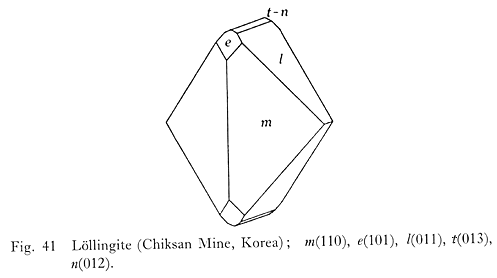
Arsenopyrite, FeAsS, Monoclinic, P21/c
< Specimens No. II-489-No. II-504 >
Specimen No. II-490, from the Ashio Mine, Tochigi Pref., occurs in drusy cavities in a chalcopyrite ore from a hydrothermal replacement copper deposit, and forms either short prismatic or tabular crystals with m(110) and u(014).
Specimen No. II-491, from the Otome Mine, Yamanashi Pref., is isolated short prismatic crystals up to 1 cm long and with m(110) and u(014), and occurs in a pegmatitic quartz vein.
Specimens Nos. II-492 & II-493, from the Iname Mine, Aichi Pref.,
occur as crystals isolated from sericite in an epithermal pyrite-stibnite-quartz
vein. These crystals are short prismatic with m(110) and u(014), and up to
2 cm in diameter. Star-shaped penetration twins are observed (Fig. 42).
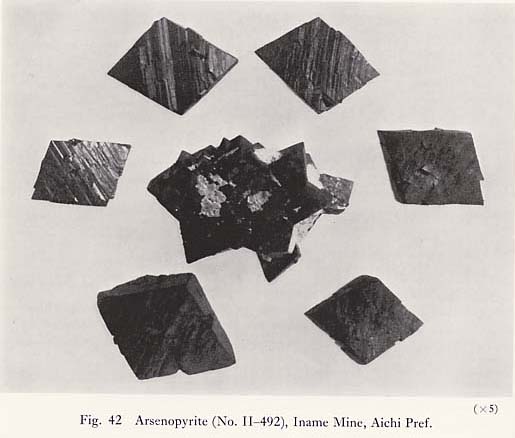
Specimen No. II-494, from the Akatani Mine, Gifu Pref., occurs in sericite as a radial aggregate of acicular crystals. The isolated crystals show basal prismatic faces, and are up to 7 mm in length.
Specimen No. II-495, from the Kuradani Mine, Ishikawa Pref., occurs in drusy cavities in a massive sulphide ore composed of sphalerite, chalcopyrite, pyrite and galena, and forms short prismatic crystals up to 5 mm in length. Associated minerals are chalcopyrite, sphalerite, and rosette aggregates of rhodochrosite.
Specimens No. II-496—No. II-498, from the Yoshioka Mine, Okayama Pref., occur in drusy parts in crystalline quartz in a contact metasomatosed copper deposit and are associated with calcite and chalcopyrite. The mineral forms prismatic or rhombic tabular crystals with m(110) and e(101), and up to 2 cm in length.
Specimen No. II-99, from. the Tawarayama Mine, Yamaguchi Pref., occurs as aggregates of small granular crystals in massive quartz.
Specimens No. II-500—No. II-503, from the Obira Mine, Oita Pref.,
occur as product of pneumatolytic metasomatism in drusy cavities in quartz
associated with fluorite and acicular crystals of tourmaline. Arsenopyrite
of these specimens forms well-defined prismatic crystals with m(110) and c(001)
and attaining 10 cm in length. Sometimes, it shows a hemispherical shape in
radial aggregation (Figs. 43 & 44).

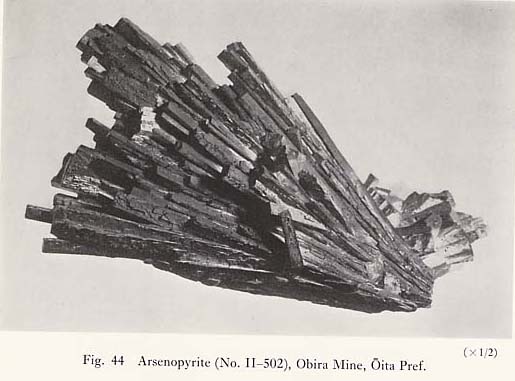
Specimen No. II-504, from the Kapsan Mine, Korea, is isolated prismatic crystals, up to 4 cm in length and with m(110) and e(101), from a contact copper deposit in a Pre-cambrian crystalline limestone, and often shows penetration twinning.
Molybdenite, MoS2, Hexagonal, P63/mmc
< Specimens No. II-505—No.II-516 >
Specimens Nos. II-505 & II-506, from the Taikyu Mine, Tochigi Pref., occur as thin flaky crystals included in an granitic pegmatite, and are associated with a small amount of scheelite.
Specimen Nos. II-507, from the Otome (Kurasawa) Mine, Yamanashi Pref., occurs in a pegmatitic quartz vein, and forms hexagonal platy crystals showing foliaceous appearance. They reach 5 cm in diameter.
Specimens No. II-508—No. II-510, from Shirakawamura, Gifu Pref.,
occur in milky-white quartz from a pegmatitic quartz vein cutting through
a granitic rock, and form hexagonal plates attaining 3 cm along the hexagonal
edge (Fig. 45).

Specimen No. II-511, from the Ebisu Mine, Gifu Pref., occurs in white massive quartz from a pneumatolytic tungsten-tin-molybdenum deposit. It forms thin flaky crystals.
Specimen No. II-512, from Fukagawadani, Hyogo Pref., occurs as aggregates of flaky crystals included in white coloured quartz from a pegmatitic quartz vein in granite.
Specimen No. II-513, from the Kakeya Mine, Shimane Pref., occurs as a massive aggregate of thin flaky crystals in quartz from a pneumatolytic molybdenum deposit.
Specimens Nos. II-514 & II-515, from the Keumgang Mine, Korea, form
hexagonal platy crystals with c(0001) and o(10![]() 1),
and occur in a pegmatitic quartz vein. The largest crystal is 5 cm along the
hexagonal edge.
1),
and occur in a pegmatitic quartz vein. The largest crystal is 5 cm along the
hexagonal edge.
Specimen No. II-516, from Sanju-myeon, Korea, occurs in white quartz, forming flaky crystals.
Proustite, Ag3AsS3, Trigonal, R3c
< Specimen No. II-517 >
Specimen No. II-517, from the Nishizawa Mine, Tochigi Pref., occurs
as red coloured thin incrustations in fractures or in cavities of quartz veins
in an epithermal gold-silver deposit, and is associated with hexagonal short
prismatic crystals of pyrargyrite with a(11![]() 0)
and e(01
0)
and e(01![]() 2),
2),
Pyrargyrite, Ag3SbS3, Trigonal, R3c
< Specimens No. II-518—No.II-521 >
Specimens Nos. II-518 & II-519, from the Sanru Mine, Hokkaido, occur in small drusy cavities in crystalline quartz in an epithermal gold-silver-bearing quartz vein, and form small granular crystals.
Specimen No. II-520, from the Ikuno Mine, Hyogo Pref., occurs as massive aggregates filling fractures or interstices of crystalline quartz in a quartz vein of a xenothermal polymetallic deposit, and is associated with sphalerite and fluorite.
Specimen No. II-521, from the Samduk Mine, Korea, is massive aggregates filling fractures or interstices of a white quartz vein.
Stephanite, 5Ag2S·Sb2S3, Rhombic, Cmc21
< Specimens No. II-522—No. II-524>
Specimens Nos. II-522 & II-523, from the Innai Mine, Akita Pref.,
occur as minute hexagonal tabular crystals and their aggregates in drusy cavities
in a quartz vein, and are associated with sphalerite, chalcopyrite and pyrite.
Sometimes, argentite forming an incrustation covers an aggregate of stephanite
(Fig. 46).

Specimen No. II-521, from the Bajo Mine, Oita Pref., occurs in drusy cavities in chalcedonic quartz associated with chalcopyrite, and forms steel-black grains attaining a few millimeters in diameter.
Polybasite, 8(Ag, Cu)2S·Sb2S3, Monoclinic, C2/m
< Specimens Nos. II-525 & II-526 >
Specimens Nos. II-525 & II-526, from the Innai Mine, Akita Pref., are hexagonal tabular crystals occurring in drusy cavities in a quartz vein of black banded texture and containing fine-grained argentite, pyrargyrite, stephanite, sphalerite, chalcopyrite, galena and pyrite.
Jamesonite, 4PbS·FeS·3Sb2S3, Monoclinic, P21/a
< Specimens No. II-527—No. II-538 >
Specimens Nos. II-527 & II-528, from the Tsugu Mine, Aichi Pref., are steel black aggregates of fine loosely matted fibrous crystals, and fill cavities or fractures of a pyrite-sphalerite ore from an epithermal quartz vein.
Specimen No. II-529, from the Bandojima Mine, Fukui Pref., is aggregates of acicular crystals covering black sphalerite crystals in cavities of a quartz vein.
Specimens No. II-530—No. II-538, from the Kuradani Mine, Ishikawa
Pref., occur in cavities in a quartz vein, are associated with sphalerite,
galena, chalcopyrite, pyrite and rhodochrosite, and form aggregates of acicular
crystals which cover the surfaces of associated minerals or fill cavities
among rhodochrosite and quartz crystals. The acicular crystals measure about
1 cm long (Fig. 47).
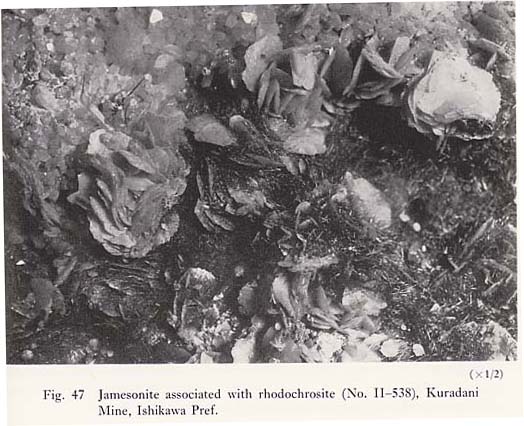
Realgar, As4S4, Monoclinic, P21/n
< Specimens No. II-539—No. II-541 >
Specimen No. II-539, from the Monji Mine, Miyagi Pref., occurs as
vein mineral in an altered volcanic rock, and forms orange-red massive aggregates
with subconchoidal fracture (Fig. 48).

Specimens Nos. II-540 & II-541, from the Nishinomaki Mine, Gumma Pref.,
occur in cavities in a quartz vein, are associated with orpiment and barite,
and form short prismatic crystals cochineal-red in colour. The main faces
are l(210), m(110), b(010) and n(![]() 12)
(Fig. 49).
12)
(Fig. 49).
Orpiment, As2S3, Monoclinic, P21/n
< Specimens No. II-542—No. II-546 >
Specimen No. II-542, from Jozankei, Hokkaid????, occurs in a quartz
vein in an altered andesite, and forms yellow to orange-yellow aggregates
of lamellar crystals with perfect cleavage on b(010) and associated with realgar.
Faces observed are o(101), m(110), x(![]() 23)
and b(010).
23)
and b(010).
Specimens No. II-543—No. II-546, from Bakuchizawa, Osoresan,
Aomori Pref., occur around volcanic fumaroles as sublimate mineral. Specimen
No. II-544 is grey to yellowish grey radial aggregates in the so-called "
comfit shape", and specimens Nos. II-545 & II-546 are yellow to reddish yellow
botryoidal incrustations of earthy orpiment associated with realgar crystals
in druses (Plate 7).

ORPIMENT (No. II-541) Osore yama, Aomori Pref.
Wakabayashilite, (As, Sb)11S18, Monoclinic, P21 or P21/m
< Specimen No. II-547 >
Specimen No. II-547, from the Nishinomaki Mine, Gumma Pref., occurs
in drusy cavities in a quartz vein, and is associated with realgar, orpiment
and pyrite. It is minute fibres elongated along the b-axis up to a few millimeters,
and forms felt-like aggregates showing golden to lemon-yellow colour with
silky lustre. This mineral is named after the late Dr. Y. Wakabayashi (Plate
1).
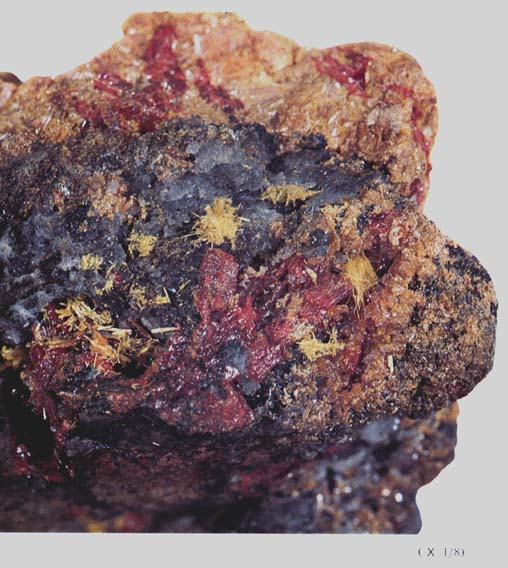
WAKABAYASHILITE (No. 11-544) (associated with realgar and orpiment) Nishinomaki
Mine, Gunma Pref. This mineral is named after Dr. Y. Wakabayashi, founder
of this collection.